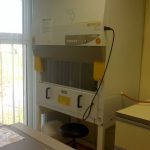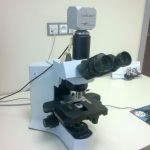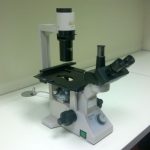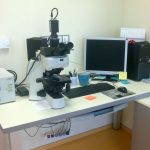Karyotyping is a cytogenetic examination that determines the chromosomal complement in cells of an individual.
Chromosomes reach their maximum condensation, i.e., have the best identifiable shape, at the metaphase of the mitotic division. By blocking the division and staining the chromosomes, we obtain a sample that allows us to determine the karyotype under the microscope. Each chromosome is stained in a characteristic pattern of light and dark bands (G-bands).
The chromosomes are evaluated using light microscopy. We first count the chromosomes, then we assess their structure. The individual chromosome pairs are numbered 1-22, the sex chromosomes are designated by the letters X and Y. We observe the distribution of light and dark bands, their size, and their intensity of staining. The human karyotype has 46 chromosomes, 22 pairs of autosomes (one set inherited from the father, the other from the mother) are equivalent for both men and women. The sexes differ in a set of gonosomes (sex chromosomes).
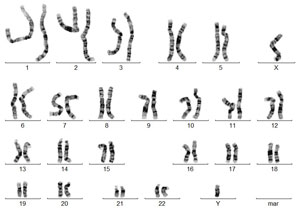
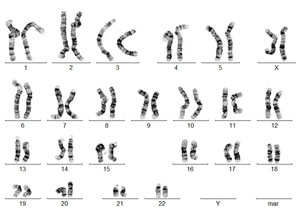
Numerical or structural abnormality of chromosomes is considered a pathological finding.
The karyotype can be determined prenatally as well as postnatally (before and after birth, respectively).
For prenatal karyotyping, we use fetal cells from the amniotic fluid or placental cells, less often fetal blood cells obtained from the umbilical cord.
By examining the fetal karyotype, we can detect both numerical and structural aberrations (e.g. the Down syndrome).
For postnatal karyotyping, we culture venous blood cells.
PERIPHERAL BLOOD SAMPLING INSTRUCTIONS:
- Collection: iodine-containing disinfectants, which may cause cell culture failure, must not be used for sampling peripheral blood.
- Draw blood into a Vacuette tube (green cap) filled with Lithium Heparin (Vacutainer collection system).
- The required blood volume for the vacuette tube must be strictly followed! (5 ml of blood must be drawn per a 5-ml tube), the least required blood volume is 2 ml (per a 2-ml tube).
- After blood sampling, invert the tube gently (mixing blood with the anticoagulant) to avoid clots and keep it at room temperature for at least half an hour.
- Then store the blood sample(s) in a refrigerator at 4-8 °C until transport.
- Transport blood samples in a thermos or a thermo-bag without cooling pads, avoid vigorous shaking, freezing, or overheating of the blood samples during transport to preserve live cells.
- Transport blood samples within 48 hours upon sampling.
The karyotype examination may, for instance, reveal the cause of recurrent miscarriages.
Our laboratory is accredited according to ČSN EN ISO 15189.
